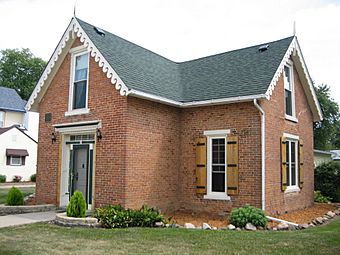Union House facts for kids
Quick facts for kids |
|
|
Union House
|
|
 |
|
| Location | 207 W. High St., Orangeville, Illinois |
|---|---|
| Area | less than one acre |
| Built | 1849 |
| Architect | John Bower (builder) |
| Architectural style | Gothic Revival, Greek Revival |
| NRHP reference No. | 00000472 |
| Added to NRHP | May 11, 2000 |
The Union House, also known as the John Bower House, is a historic home in Orangeville, Illinois. It's mostly built in the Gothic Revival style. It was the very first brick house in Orangeville. John Bower, who founded the village, built it in 1849. Later, in 1885, Samuel Hutchins bought the house. His family lived there for many years, until 1951. The Union House mixes two old building styles: Greek Revival and Gothic Revival. It's the only Gothic Revival building you'll find in Orangeville! This special house was added to the U.S. National Register of Historic Places in 2000.
History of the Union House
The Union House was the first brick house built in Orangeville, Illinois. It was built by John Bower, who founded the village. Bower came to Stephenson County, Illinois in 1844. On October 16, 1846, he bought the land that would become Orangeville. He paid US$950 for it.
Bower built the Union House in 1849. Orangeville was officially started in 1851. By 1885, Dr. Samuel Hutchins and his wife Amanda owned the house. Dr. Hutchins used it as his home and medical office. William Hutchins inherited the home next. He lived there until he passed away in 1926. His sister Katherine Hutchins then took over the building. When Katherine died in 1944, her mother Linda inherited the house.
In 1951, the house was sold to Robert and Florence Shafer. The Shafers then sold it to Val and Opel Schreiner. The Schreiners owned the house when it was nominated to the U.S. National Register of Historic Places in 2000.
Architecture: A Mix of Styles
The Union House uses a mix of Greek Revival and Gothic Revival building styles. You can see the Greek Revival style in the front doorway. It looks very much like descriptions of Greek Revival doorways. These doorways often have fancy frames. They also have decorative glass panels on the sides, called sidelights. Sometimes, there are fan-shaped windows above the door, called fanlights. The Union House has these features.
Most of the house, besides the front door, is in the Gothic Revival style. This style became popular in the United States from the late 1830s to the 1850s. Gothic Revival homes often have decorative bargeboards. These are carved boards along the edges of the roof. They also have steeply sloped roofs and pointed gables. Windows often go up into the gables. All these features are on the Union House. The original decorative bargeboarding is still there.
Why the Union House is Important
The Union House is special for a few reasons. It was the first brick house built in Orangeville. It is also the only example of Gothic Revival architecture in the village. The house is important locally because John Bower, the village founder, built it.
The house is also a great example of how building styles changed. It blends parts of both Greek Revival and Gothic Revival styles. Because of its local history and unique architecture, the Union House was added to the U.S. National Register of Historic Places. This happened on May 11, 2000.




